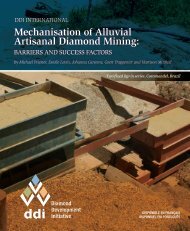Mechanisation-Alluvial-Artisanal-Diamond-Mining
Mechanisation-Alluvial-Artisanal-Diamond-Mining
Mechanisation-Alluvial-Artisanal-Diamond-Mining
You also want an ePaper? Increase the reach of your titles
YUMPU automatically turns print PDFs into web optimized ePapers that Google loves.
8<br />
3 Key factors<br />
influencing the<br />
mechanisation Process<br />
The factors which determine mechanisation can be<br />
broadly organised into the drivers, i.e. what makes<br />
it desirable, and the barriers and success factors,<br />
i.e. what makes it possible, or not.<br />
3.1 Drivers for <strong>Mechanisation</strong><br />
The principal drivers for mechanisation are<br />
commercial, socio-cultural and environmental<br />
reasons. With the view to economics the miners<br />
expect higher returns due to the faster exploitation,<br />
less effort, higher recovery and security as well as<br />
a safety gain. This is combined with a higher social<br />
reputation and social status as a consequence<br />
of the mechanisation. Finally, miners expect<br />
to overcome seasonal limitations to artisanal<br />
mining and get access to deeper deposits. Either<br />
alone or in combination, the commercial drivers<br />
increase the likelihood and potential size of profit,<br />
so helping miners achieve greater financial gain<br />
and independence. With so much to gain, the key<br />
questions then are: what are the barriers preventing<br />
artisanal miners from mechanizing? And what are<br />
the factors ensuring success when someone does<br />
attempt to mechanise?<br />
3.2 Key Barriers and Success Factors<br />
to <strong>Mechanisation</strong><br />
Whilst there are indeed technical reasons why<br />
mechanisation is sometimes not possible,<br />
desirable or successful, other factors can be even<br />
more important. These include the existence<br />
or non-existence of certain political, legal,<br />
financial, cultural, organisational, or demographic<br />
conditions, or the inability of miners to access<br />
these conditions even if they do exist.<br />
3.2.1 – Enabling environment 3<br />
The political order in the country and the mining<br />
regions influences the potential for mechanisation<br />
by affecting the investment climate and the<br />
outlook for success of mechanisation projects (i.e.<br />
conflict or post-conflict situation vs. stable political<br />
environment with effective institutions).<br />
The administrative requirements for<br />
formalisation potentially pose many traps for<br />
mechanisation projects. In many systems there<br />
are numerous incentives for miners to remain<br />
informal. Getting a digging operation licensed can<br />
be enormously time consuming and expensive.<br />
The legal framework of licensing in some<br />
countries (e.g. Sierra Leone, Guinea) prohibits<br />
mechanisation for ASM licenses directly or<br />
discourages it indirectly. There are legal barriers<br />
or a complete lack of mechanisms to evolve from<br />
legalised ASM to mechanised operations. On the<br />
other hand, a legal system allowing “tributor”<br />
agreements between a title holder and ASM (such<br />
as in Ghana between GCD and the diamond<br />
mining groups) poses favourable conditions for<br />
mechanisation.<br />
The capacity and will of local or national<br />
authorities to enforce the law influences the<br />
potential for mechanisation by affecting the<br />
investment climate. The requirement of registering<br />
equipment, excessive or informal taxation on those<br />
using machines, and corruption relating to the<br />
access or use of machines can all disincentivise<br />
mechanisation. In countries with fragile governance<br />
structures (i.e. Guinea and DRC) the mechanisation<br />
of ASM has tended to proceed very slowly, while<br />
in countries with a stable political economy and<br />
implementation of the legal framework (i.e. Brazil<br />
and Guyana) the modernisation of exploitation<br />
is quite advanced.<br />
3<br />
This covers the political environment, legal, institutional and<br />
commercial issues setting the frame for mining activities in a country



